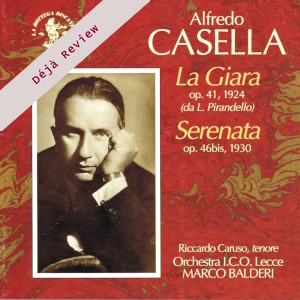
Déjà Review: this review was first published in March 2007 and the recording is still available.
Alfredo Casella (1883-1947)
La Giara Op.41 (1924) [29:32]
Serenata Op.46bis (1930) [22:19]
Riccardo Caruso (tenor)
Orchestra I.C.O. Lecce/Marco Balderi
rec. 1997, Studio Elite, Sermide, Italy
La Bottega Discantica BDI23 [52]
There’s a pairing of these two works on Naxos, filled out with Casella’s Paganiniana but I’ve not heard it. So far as I can tell that is actually the symphonic suite and not, as here, the full ballet which contains a vocal scene and other movements that were excised to form the slimmer version. In any case Casella’s La Giara seldom goes really wrong unless one overplays it. Here things seem perfectly acceptable.
Late Romanticism jostles with burlesque, Stravinsky and moments of luscious string cushions – and that’s only the first scene. There’s breezy folkloric dance music in the second scene and the vaguest of hints of the kind of thing that Alfano, Wolf-Ferrari, Respighi and their confrères were discovering at the same time – though Casella was never of their camp. In fact Casella, as ever, manages to sound more like a head-on collision between Rossini and Milhaud. There are Max Steiner moments too – though that’s a retrospective suggestion given that Casella was writing in 1924 – and a definite homage to the Rite of Spring in its rhythmic charge. Casella’s control of rhythm, colour, balance and proportion is finely judged – and well realised in this performance. There’s a comedia dell’arte appeal to much of Casella’s comedic writing – did Lord Berners hear this? – and also some neo-classical moments that sound disconcertingly like the Parisian Martinů as well, at the end. All right, not all the influences quite work but this is a glorious piece, full of kaleidoscopic variety. Hear it at least once in your carbon-footprinted, mortgaged-up-to-the eyeballs life.
The Serenata was originally written in 1927 for clarinet, bassoon, trumpet, violin and piano. In 1930 he transcribed it for larger forces, hence its designation as Op.46bis. It possesses some of the stronger traits that made the ballet so enjoyable. Certainly there’s neo-classicism here and there’s something almost caricatured in the filmic exaggeration of the Notturno – and touches of Mahler, touches of things Iberian. There’s refined lyricism here too in the touching Cavatina and a brisk, brash and biting Finale.
At fifty-two minutes I’d be remiss not to note that there is a missing work here. But the performances are enjoyable, engaging, convincing and unostentatiously recorded. And La Giara is a superbly bubbling brew that demands to be heard.
Jonathan Woolf
Help us financially by purchasing from


















